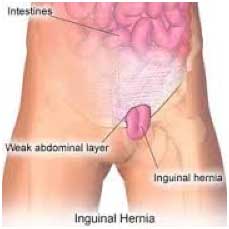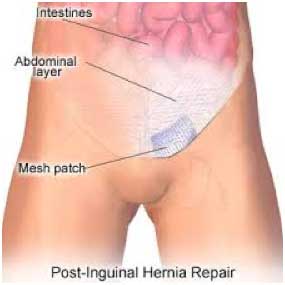Inguinal Hernia Repair – Single
 An Inguinal Hernia is a condition that occurs in the groin area when fatty or intestinal tissues push through the inguinal canal. The inguinal canal is located at the base of the abdomen and is closed. Men and woman have an inguinal canal. In men, the testes descended through the canal shortly before birth. The uterus ligament is located in the canal in women. When there is a hernia in this passage, it results in a protruding bulge that may be painful on movement. There are two types of Inguinal Hernias: Indirect and Direct. An Indirect Inguinal Hernia is the most common type. It often occurs in premature births, when the inguinal canal is not fully developed. However, this type of hernia can occur at any time during your life. Surgery is the primary treatment for inguinal hernias and a very common operation, and highly successful procedure. Your doctor will recommend either herniorrhaphy (“open” repair) or laparoscopy. Open repair involves making an incision into the groin and returning the abdominal tissues into the abdomen and repairing the abdominal wall defect. Laparoscopy uses several small incisions rather than a singleincision. This surgery may be preferable if you want a shorter recovery time.
An Inguinal Hernia is a condition that occurs in the groin area when fatty or intestinal tissues push through the inguinal canal. The inguinal canal is located at the base of the abdomen and is closed. Men and woman have an inguinal canal. In men, the testes descended through the canal shortly before birth. The uterus ligament is located in the canal in women. When there is a hernia in this passage, it results in a protruding bulge that may be painful on movement. There are two types of Inguinal Hernias: Indirect and Direct. An Indirect Inguinal Hernia is the most common type. It often occurs in premature births, when the inguinal canal is not fully developed. However, this type of hernia can occur at any time during your life. Surgery is the primary treatment for inguinal hernias and a very common operation, and highly successful procedure. Your doctor will recommend either herniorrhaphy (“open” repair) or laparoscopy. Open repair involves making an incision into the groin and returning the abdominal tissues into the abdomen and repairing the abdominal wall defect. Laparoscopy uses several small incisions rather than a singleincision. This surgery may be preferable if you want a shorter recovery time.
Preparation for Inguinal Hernia Repair-Single Surgery
 When you meet with your doctor before the surgery:
When you meet with your doctor before the surgery:
- Bring a list of all prescription and over-the-counter medications you take. Make sure you ask for instructions about which medications you need to stop taking before surgery. Usually this includes drugs that interfere with the blood’s ability to clot, such as aspirin.
- Ask your doctor for specific instructions regarding the procedure and your medical condition.
- You will be probably advised to stop eating or drinking after midnight on the night before your surgery.
- You will also need to arrange for someone to drive you home from the hospital after surgery.
Procedure for Inguinal Hernia Repair-Single Surgery
An Inguinal Hernia can be repaired with traditional surgery or with a laparoscope (a thin, lighted tube with a camera on the end).
Open Surgery: General anesthesia will be used, so you will not be awake during the surgery. Your surgeon might decide on a local anesthesia if the hernia is small. In this case, you will be aware, but will receive medications to numb the pain and help you relax. The surgeon will make an incision, locate the hernia, and separate it from surrounding tissues. The herniated tissue will be pushed back into place in your abdomen. Stitches will be used to close up the tear or strengthen weak abdominal muscles. Sometimes mesh is attached to strengthen the abdominal tissues and reduce the risk of another hernia.
Laparoscopy: Laparoscopy can be used when the hernia is small in size and easy to access. This method leaves smaller scars than regular surgery, and recovery time is faster. The procedure is the same as for open surgery, only using a laparoscope and miniaturized instruments.
Recovering from Inguinal Hernia Repair-Single Surgery
You will probably be encouraged to get up about an hour after surgery. Men sometimes have difficulty urinating in the hours following surgery, but this can be relieved with a catheter (a tube that drains urine from the bladder). This surgery is often performed as an outpatient procedure. If you have traditional surgery, it may take up to six weeks for a full recovery. With laparoscopy, you will probably be able to get back to your normal activities within a few days.
Inguinal Hernia Repair-Single Risks Factors
Risks involved in any surgery include:
- Breathing difficulties
- Bleeding
- Allergic reactions to anesthesia and other medications
- There are also some risks specific to Inguinal Hernia repair. For example:
- The hernia may eventually come back.
- You may experience prolonged pain at the site.
- There could be damage to blood vessels. In men, the testicles could be harmed if connecting blood vessels are damaged.
- There could be nerve damage or damage to nearby organs.
Prevention and Outlook of Inguinal Hernia-Single Repair
Early treatment can help cure Inguinal Hernias. However, there is always the slight risk of complications, such as infection after surgery, scars, and the recurrence of the hernias. Call your doctor if you experience new symptoms or if side effects occur after treatment. Although you cannot prevent genetic defects that may cause the hernias, you can possibly lessen their severity by:
- Maintaining a healthy weight
- Eating a high-fiber diet
- Not smoking
- Avoiding heavy lifting
